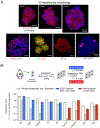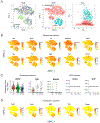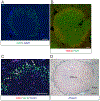Inflammatory Cytokine TNFα Promotes the Long-Term Expansion of Primary Hepatocytes in 3D Culture
- PMID: 30500539
- PMCID: PMC6497386
- DOI: 10.1016/j.cell.2018.11.012
Inflammatory Cytokine TNFα Promotes the Long-Term Expansion of Primary Hepatocytes in 3D Culture
Abstract
In the healthy adult liver, most hepatocytes proliferate minimally. However, upon physical or chemical injury to the liver, hepatocytes proliferate extensively in vivo under the direction of multiple extracellular cues, including Wnt and pro-inflammatory signals. Currently, liver organoids can be generated readily in vitro from bile-duct epithelial cells, but not hepatocytes. Here, we show that TNFα, an injury-induced inflammatory cytokine, promotes the expansion of hepatocytes in 3D culture and enables serial passaging and long-term culture for more than 6 months. Single-cell RNA sequencing reveals broad expression of hepatocyte markers. Strikingly, in vitro-expanded hepatocytes engrafted, and significantly repopulated, the injured livers of Fah-/- mice. We anticipate that tissue repair signals can be harnessed to promote the expansion of otherwise hard-to-culture cell-types, with broad implications.
Keywords: 3D culture; TNFα; Wnt; hepatocyte; inflammatory cytokine; injury; liver; organoid; regeneration.
Copyright © 2018 Elsevier Inc. All rights reserved.
Conflict of interest statement
DECLARATION OF INTERESTS
The authors declare no competing interests.
Figures







References
-
- Akerman P, Cote P, Yang SQ, McClain C, Nelson S, Bagby GJ, and Diehl AM (1992). Antibodies to tumor necrosis factor-alpha inhibit liver regeneration after partial hepatectomy. Am. J. Physiol 263, G579–G585. - PubMed
-
- Arnett HA, Mason J, Marino M, Suzuki K, Matsushima GK, and Ting JP (2001). TNF alpha promotes proliferation of oligodendrocyte progenitors and remyelination. Nat. Neurosci 4, 1116–1122. - PubMed
Publication types
MeSH terms
Substances
Grants and funding
LinkOut - more resources
Full Text Sources
Other Literature Sources
Molecular Biology Databases
Research Materials
Miscellaneous

